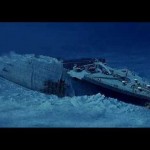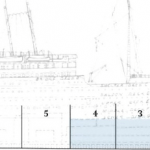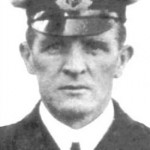 Whenever something bad happens, people always look for some kind of explanation. What happened that caused the tragedy? Why did people have to get injured or die? A typical question would be what could have been done differently that fateful night? One of the biggest disasters of the 20th century involved the sinking of the RMS Titanic. The disaster happened the night of April 15, 1912, and over 1500 people died in the frigid waters of the North Atlantic. The ship was carrying not only cargo, but also both the richest and poorest people in the world at that time. The Titanic hit an iceberg and sank slowly over the course of two hours, but there were 705 survivors that were rescued. Once these survivors got to New York City, there was an inquiry to see if the disaster could have been prevented? Here are three more ways that the Titanic disaster could have been avoided.
Whenever something bad happens, people always look for some kind of explanation. What happened that caused the tragedy? Why did people have to get injured or die? A typical question would be what could have been done differently that fateful night? One of the biggest disasters of the 20th century involved the sinking of the RMS Titanic. The disaster happened the night of April 15, 1912, and over 1500 people died in the frigid waters of the North Atlantic. The ship was carrying not only cargo, but also both the richest and poorest people in the world at that time. The Titanic hit an iceberg and sank slowly over the course of two hours, but there were 705 survivors that were rescued. Once these survivors got to New York City, there was an inquiry to see if the disaster could have been prevented? Here are three more ways that the Titanic disaster could have been avoided.
4. The Watertight Bulkheads Could Have Gone Higher
 J. Bruce Ismay, and Lord Pirrie, had the idea to make three beautiful ships that would be the queens of luxury. The RMS Olympic was built first, and then the Titanic was constructed. However, when Pirrie and Ismay first envisioned these ships, they were going for the most luxury, and while safety was a concern, it was not their biggest priority. The ship was equipped with watertight bulkheads, but the problem was that they did not go up beyond a certain level. When the iceberg accident happened, the steel plates and rivets were scraped off, and the ship began to fill with water. The bulkheads were divided into 16 compartments, and when the iceberg collision occurred, the bridge closed the doors between them, but the problem is that they were not topped with watertight tops. As the Titanic began to sink, the weight of the water pulled the ship down to a point where the water began to slop over the top of the bulkhead, then pour into another like an ice cube tray. The water flowing from one compartment to another, only adding to the sinking, and ultimately doomed the ship.
J. Bruce Ismay, and Lord Pirrie, had the idea to make three beautiful ships that would be the queens of luxury. The RMS Olympic was built first, and then the Titanic was constructed. However, when Pirrie and Ismay first envisioned these ships, they were going for the most luxury, and while safety was a concern, it was not their biggest priority. The ship was equipped with watertight bulkheads, but the problem was that they did not go up beyond a certain level. When the iceberg accident happened, the steel plates and rivets were scraped off, and the ship began to fill with water. The bulkheads were divided into 16 compartments, and when the iceberg collision occurred, the bridge closed the doors between them, but the problem is that they were not topped with watertight tops. As the Titanic began to sink, the weight of the water pulled the ship down to a point where the water began to slop over the top of the bulkhead, then pour into another like an ice cube tray. The water flowing from one compartment to another, only adding to the sinking, and ultimately doomed the ship.
5. Jack Phillip and Harold Bride Could Have Delivered the Iceberg Warnings More Urgently
 There were over 2200 people on board the RMS Titanic when she set sail from Southampton. The voyage took four days, and during that time, the First Class passengers especially, wanted to send messages to their loved ones, and used the wireless room to do it. Now the important thing to remember is that the wireless had a duty to monitor the airwaves, but it was difficult to do with the passengers constantly sending messages. In between all the messages, other ships were sending urgent messages to be taken to the bridge officers, warning them about the ice. However, it is not known how many of these messages actually made it to the bridge, and it was a comment that Second Officer Charles Lightoller made during the Senate hearings about the disaster, and he claimed that if he had seen these warnings he would have insisted the ship slow down.
There were over 2200 people on board the RMS Titanic when she set sail from Southampton. The voyage took four days, and during that time, the First Class passengers especially, wanted to send messages to their loved ones, and used the wireless room to do it. Now the important thing to remember is that the wireless had a duty to monitor the airwaves, but it was difficult to do with the passengers constantly sending messages. In between all the messages, other ships were sending urgent messages to be taken to the bridge officers, warning them about the ice. However, it is not known how many of these messages actually made it to the bridge, and it was a comment that Second Officer Charles Lightoller made during the Senate hearings about the disaster, and he claimed that if he had seen these warnings he would have insisted the ship slow down.
6. First Officer William, Murdoch Could Have Had a Different Reaction to the Iceberg
 No one knows how they will react during a crisis until one actually happens to them. On the night of the Titanic disaster, First Officer William Murdoch was on the bridge, and when word came from Fleet and Lee about the iceberg, many say he reacted with panic and put the ship in reverse. By reversing a big ship like Titanic, it made it less maneuverable, which is why turning it away from the iceberg did not really work. If Murdoch had not panicked, and just turned the wheel hard over without reversing the engine, the iceberg collision may have been avoided all together.
No one knows how they will react during a crisis until one actually happens to them. On the night of the Titanic disaster, First Officer William Murdoch was on the bridge, and when word came from Fleet and Lee about the iceberg, many say he reacted with panic and put the ship in reverse. By reversing a big ship like Titanic, it made it less maneuverable, which is why turning it away from the iceberg did not really work. If Murdoch had not panicked, and just turned the wheel hard over without reversing the engine, the iceberg collision may have been avoided all together.
When disaster strikes, people always want to blame someone, and also wonder if something could have been done to prevent the disaster. These two posts have put forth a total of six ways that the Titanic disaster could have been avoided. However, who is to say that doing any of these things could have made a difference? Perhaps even if the iceberg warnings were given to the bridge, or the bulkheads were built much higher, that the ship would have sunk anyway? Disasters and death are a part of life, and sometimes nothing can be done to avoid them. Perhaps the big ship, the RMS Titanic was never meant to sail more than once, and the world may have been a very different place if it had never been built. However, time cannot be reserved, and the Titanic did sink, and now all that people can do is learn from its tragic sinking, and hopefully, something like this will never happen again.

